Subsidiary Verbs / Pay / 'Go' and / Maa / 'Come' in Thai �����Ե �ش� �ѧ�ؾѹ��� Suda Rangkupan �����Ҩ�������֡�� �� ��觡ҭ��� �ҭ��� Dr Kingkarn Thepkanjana ����ʶҺѹ ����ŧ�ó�����Է�����. �ѳ�Ե�Է����� Chulalongkorn University. Bangkok. (Thailand). Graduate School. �дѺ��ԭ�������������´�Ң��Ԫ� �Է�ҹԾ�����Һѳ�Ե. �ѡ����ʵ�� (������ʵ��) Master. Arts (Linguistics) �շ�診����֡�� 2535 ���Ѵ���(��) �Է�ҹԾ������ըش������·����֡�Ҥ������¢ͧ������ͧ � ����� 㹻���¤�������ա�������§������� ����������ͧ � ����� ��ࡳ��㹡�è�ṡ�������ͧ�ӡ����������� ����Ԩ�¾���� � ��� �� 㹰ҹз���繡�����ͧ����ͻ�Сͺ���ա�������§����������������ԧ��鹷��������Ҵѧ��� ��ԧ��鹷�� ��ʴ�����������ش����㹷�ȷҧ�����ҧ�͡�ҡ�ش��ҧ�ԧ�ͧ���ٴ ���ʴ�����������ش����㹷�ȷҧ������������ش��ҧ�ԧ�ͧ���ٴ ��ԧ���� � �ʴ�����ͧ�˵ء�ó�ͧ���ٴ��Ҽ��ٴ����˵ء�ó��鹴��Թ���仨ҡ���ҷ����ٴ����Ƕ��¤� ���ʴ�����ͧ�˵ء�ó�ͧ���ٴ��Ҽ��ٴ����˵ء�ó��鹴��Թ�Ҩ��֧���ҷ����ٴ����Ƕ��¤� 㹡���� � ��� �� ��ṡ�������ӡ���ҹ�� ����Ԩ�¾���� ��ԧ��鹷�� �ӡ���ҡ�����������ö��ҡ������Ѻ�ӡ���ҷ���ͧ���鹤�ͤӡ��������ǡѺ���������� �ӡ��������ǡѺ��ä�ͺ��ͧ �ӡ��������ǡѺ���������� �ӡ��������ǡѺ�����������µç�ͧ������ ��� �ӡ��������Ǣ�ͧ�Ѻ����ͧ ����ѧ����� � ����ö�Դ��ѧ�ӡ�����ʴ���û����Թ��������ʴ��س�����л���ҳ����Թ��¨ҡࡳ������ٴ������ ��ԧ��鹷���� �ӡ���ҷ������ö��ҡ������Ѻ�ӡ���ҷ���ͧ�����շ�駤ӡ���ҷ���ʴ���кǹ�����Фӡ�����ʴ���Ҿ ����ѧ���ա��� �� ����ö�Դ��ѧ�ӡ������ѡ � �����ʴ����������§�˵ء�ó� "�" �������ش������ʹյ�Ѻ���ҷ����ٴ����Ƕ��¤ӹ�� ���Ѵ���(English) This thesis aim at analyzing the meaning of payl and maalas subsidiary verbs in serial verb constructions in Thai and usedthem as criteria in classifying verbs in Thai. It is found that subsidiary verbs payl 'go' and maal 'come'in serial verb constructions denote spatial and temporalmeanings. Spatially, payl denotes a motion away from thespeaker's point of reference; maal denotes a motion toward thespeaker' point of reference. Temporally, payl is used to denotethat the speaker views that a situation proceeds away from theutterance time; maal is used to denote that the speaker viewsthat a situation proceeds up to the point of the utterance time. It is also found that the main verbs which can be spatiallymodified by payl and maal are verbs of displacements, verbs ofpossession, verbs of communication, verbs of direct bodily actionand verbs of vision. Payl can also be used to modify evaluationverbs to denote that the speaker views the qualities orquantities denoted by evaluation verbs as being excessive.Temporally, payl and maal can be used to modify process verbs andstative verbs. Moreover, maal is found to modify the main verbpayl to denote the temporal extension of the past event 'going'to the utterance time. ���ҷ������¹�Է�ҹԾ��� �ӹǹ˹�Ңͧ�Է�ҹԾ��� 180 P. ISBN 974-581-714-7 ʶҹ���Ѵ���Է�ҹԾ��� ���Ӥѭ SUBSIDIARY VERB, PAYL, MAAL, THAI �Է�ҹԾ���������Ǣ�ͧ �����Է�ҹԾ��� ���������������͡Ẻ��ʫԧ�ٻ����Ѻ��ô֧�ѹ����� ANALYSIS AND DESIGN OF CLOSING LOOPS FOR CANINE RETRACTION. �����Ե ��Թ��� ����ҡó� Varintra Ungbhakorn �����Ҩ�������֡�� �.��.��. 侺���� ൪����������.��. ��Է��� ����ҡó� Paiboon Techalertpaisarn, Ph.D.Prof Variddhi Ungbhakorn, Ph.D. ����ʶҺѹ ����ŧ�ó�����Է�����. �ѳ�Ե�Է����� Chulalongkorn University. Bangkok. (Thailand). Graduate School. �дѺ��ԭ�������������´�Ң��Ԫ� �Է�ҹԾ�����Һѳ�Ե. �Է����ʵ�� (�ѹ������Ѵ�ѹ) Master. Science (Orthodontics) �շ�診����֡�� 2546 ���Ѵ���(��) �ѵ�ػ��ʧ��ͧ����Ԩ�¤�� �������º��º��Ҥ����秵֧�ͧ��ʫԧ�ٻ�������ҡ��äӹdz�����ɮպ��ͧ��ʵԡ�������Шҡ��÷��ͧ �����������ҧ����ʫԧ�ٻ���Ѵ�ҡ�Ǵ���硡������ʹ����Ҵ 0.016x0.022 ���� �ӹǹ 4 �ٻẺ�ٻẺ�� 5 �ٻ ���� vertical helical loop, T-loop, Opus90 loop ��� helicalT-loop ������Ѵ��ǹ����Ѵ��ǹ���������ѵ����ǹ����������ç�����ҡ��äӹdz�ҧ��ɮ��ҡ����ش �����Ѵ��Ҵ�ç��Ǣ�ҹ�Ѻ�Ңͧ�ٻ����дѺ�����ҡ����ͤ���Ƿ��������ͤ���Ƿ 0.50, 1.00, 1.50, 2.00, 2.50 ��� 3.00 ��. ������´��ٹ���������ʵԧ����չ��� LF plus ���º��º��Ҥ����秵֧�ͧ��ʫԧ�ٻ��� 4 �ٻẺ �����ҡ��äӹdz�ҧ��ɮ���Шҡ��÷��ͧ ����ʶԵԷ��ͺ�������¢ͧ��Ъҡ����Ƿ���дѺ����Ӥѭ .05 �š���Ԩ�¾���� ��Ҥ����秵֧�ͧ vertical helical loop, T-loop, Opus90loop ��� helical T-loop �����ҡ��äӹdz�����ɮպ��ͧ��ʵԡ�������ҡѺ33.80, 23.80, 19.60 ��� 23.50 ����/��. ����ӴѺ ��ǹ��Ҥ����秵֧�����ҡ��÷��ͧ��ҡѺ 81.90, 59.63, 55.94 ��� 47.66 ����/��. ����ӴѺ ��÷��ͺ�������¢ͧ��Ъҡ����Ǿ���� ��Ҥ����秵֧�ͧ��ʫԧ�ٻ��� 4 �ٻẺ�����ҡ��÷��ͧ�����ҡѺ��Ҥ����秵֧�����ҡ��äӹdz�ҧ��ɮշ���дѺ����Ӥѭ.05 (p = .000) �ѧ��鹷�ɮպ��ͧ��ʵԡ����֧�������������й�����ӹdz�Ҥ�Ҥ����秵֧�ͧ��ʫԧ�ٻ ���ҧ�á����ŷҧ��ɮ��ѧ�ջ���ª��㹡�÷�����Һ�Է�ԾŢͧ���������¹�Ѵ��ǹ��ҧ� �ͧ�ٻ��ͤ���ѵ����ǹ����������ç��Ф�Ҥ����秵֧ ���Щй�鹷�ɮպ��ͧ��ʵԡ��������Ըա�÷ҧ��Ե��ʵ�����Ҩ����ǹ����㹡���͡Ẻ ������㨤س�ѡɳТͧ��ʫԧ�ٻ�ѹ�Դ�ҡ�Ѵ��ǹ��ҧ� �ͧ�ٻ�� ���Ѵ���(English) The objectives of this research is to compare values of the stiffnesses of theclosing loops calculated by Castigliano's theorem to those by experimental results.Selected samples are the closing loops constructed from 0.016x0.022 inch stainlesssteel wire. They are four types of closing loops, namely, vertical helical loop, T-loop,Opus90 loop and helical T-loop, each with five samples. The configuration of eachtype of loops corresponds to the configuration which gives maximum MIF ratio theoretically.The activated forces are measured by applying the force parallel to the horizontal legsof each loop using Lloyd universal testing machine LF plus. The activated displacementsare 0.50, 1.00, 1.50, 2.00, 2.50 and 3.00 mm. The resulting values of loop stiffnessesobtained from experiment are then compared to the theoretical stiffnesses by usingthe test statistic one-sample t-test at .05 significant level. The Castigliano's theorem predicts the values of loop stiffnesses of the verticalhelical loop, T-loop, Opus90 loop and helical T-loop to be 33.80, 23.80, 19.60 and23.50 gm/mm respectively. The experimental values of the corresponding closing loopsare 81.90, 59.63, 55.94 and 47.66 gm/mm respectively. From the t-test, it is found out thatthe stiffness values of the four closing loops obained from experiment are not equal tothose from theory at .05 significant level (p = .000). Hence, the Castigliano's theorem is,not suitable for calculating the loop stiffness. However, the theoretical results still showthe influence of variable dimensions of the closing loop on the MIF ratios and stiffnesses.Therefore, the Castigliano's theorem is still the mathematical method which may facilitatethe design and understand the characteristics of the closing loop formed from various dimensions. ���ҷ������¹�Է�ҹԾ��� �ӹǹ˹�Ңͧ�Է�ҹԾ��� 108 P. ISBN 974-17-3514-6 ʶҹ���Ѵ���Է�ҹԾ��� ���Ӥѭ STIFFNESS, CLOSING LOOP, CASTIGLIANO, CONFIGURATION, M, F �Է�ҹԾ���������Ǣ�ͧ |

กระทู้ที่เกี่ยวข้อง
การโฆษณา
ข่าวล่าสุด
การโฆษณา
ผู้มีอำนาจ
การโฆษณา
ถูกกฎหมาย
ช่วย

ลิขสิทธิ์ © 2024 th.apacode Inc.




























